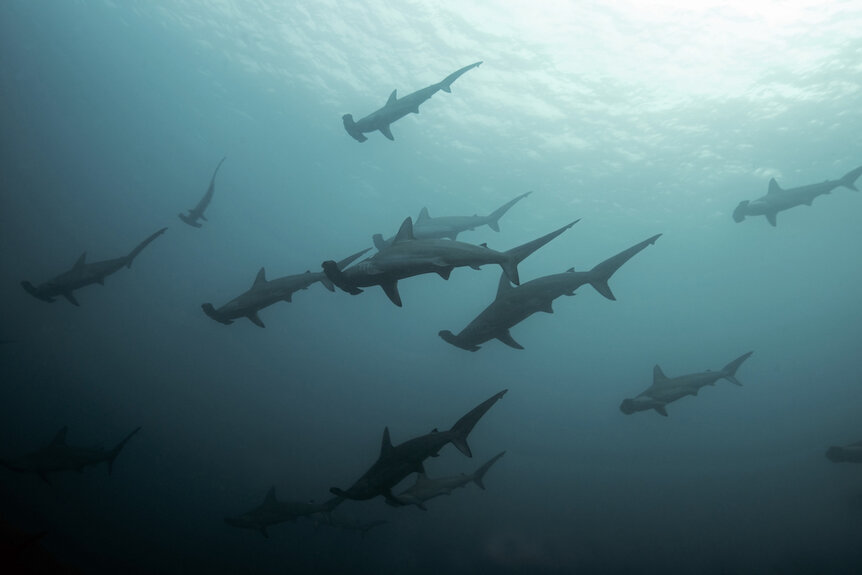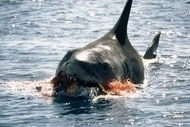Create a free profile to get unlimited access to exclusive videos, sweepstakes, and more!
Even Sharks Sometimes Have to Hold Their Breath
And it's for a weird reason.

Steven Spielberg’s 1975 masterpiece Jaws, based on the Peter Benchley novel of the same name, was the original summer blockbuster. It tells a story of man versus fish; more specifically, it tells the story of three men — Roy Scheider as Brody, Richard Dreyfuss as Hooper, and Robert Shaw as the grizzled boat captain Quint — against a particularly aggressive fish. The fish in question is a great white shark and it’s entirely in its element, hunting in the warm shallows off the New England Coast. The humans, on the other hand, have to hunt the shark on its own turf where they can’t even manage to breathe.
Hammerhead sharks, it turns out, may be sympathetic to the struggles of hunting outside of one's natural environment. They’re most comfortable in warm, shallow waters, but are known to dive thousands of feet into the depths in search of food. And while they don’t need a bigger boat, they have evolved an unexpected ability which helps them to survive while diving. Hammerhead sharks hold their breath.
WHY SOME SHARKS HOLD THEIR BREATH WHILE HUNTING
Sharks are ectothermic, which is just a fancy science way of saying cold-blooded. Unlike warm-blooded animals, they don’t have any internal way of maintaining their body temperature. Instead, they rely on the temperature of the waters around them to keep their biological machinery running smoothly.
RELATED: Steven Spielberg 'Truly' Regrets Demonization Of Sharks And Harmful Sport Fishing Caused By Jaws
That’s easy enough in their usual stomping grounds in warm, coastal waters, but that’s not where they find all of their food. Researchers have observed scalloped hammerheads diving more than 2,600 feet (800 meters) beneath the surface, in search of fresh, tasty squid.
That far down, almost all of the sunlight has been filtered out, resulting in what some scientists refer to as the twilight zone. In that region, between 200 and 1,000 meters deep, levels of light drop dramatically, below what’s needed for photosynthesis, and the temperatures plummet to about 41 Fahrenheit (5 Celsius). Even for humans, with our impressive metabolic heat control systems, swimming in waters that cold would be unpleasant. For hammerhead sharks, it should be deadly. And yet, they pull it off.
To find out how, scientists temporarily captured scalloped hammerheads and equipped them with a suite of electronic instruments to track their movements and biological activity. It’s basically a smart wearable for a shark. When researchers got the data back, they found that sharks dive thousands of feet deep for only a few minutes at a time, according to the study, published in the journal Science. Once the sharks are done snacking, they turn tail and rocket for the surface. Notably, the sensors showed no decrease in body temperature while they were diving, and only a temporary and moderate drop in body temperature after they began to surface.
That’s because scalloped hammerheads squeeze their gill slits closed while diving, preventing water from passing through their gills. No passing water means they can’t breathe, but it also means cold water isn’t passing through the most exposed part of their bodies, where it can pull away heat. They hold their breath, not out of any sense of anticipation, but to stay warm. Then, when they get nearer the surface and back to warmer waters, they open back up, causing a slight drop in body temperature while they’re still rising.
Despite having inhabited the Earth for hundreds of millions of years, there’s still a lot we don’t know about sharks. The use of remote monitoring equipment like wireless sensors is crucial for understanding the behavior of one of our planet’s most successful animals. We might even learn a way for us to live together peacefully, but maybe don't hold your breath.
Catch Steven Spielberg’s seminal adventure thriller, Jaws, available from Universal Pictures.



























